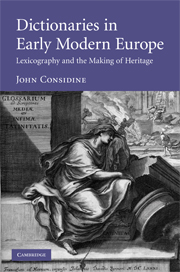Book contents
- Frontmatter
- Dedication
- Contents
- Acknowledgements
- Conventions and abbreviations
- Chapter 1 Introduction
- Chapter 2 The classical heritage I: Philology and lexicography
- Chapter 3 The classical heritage II: Henri Estienne and his world
- Chapter 4 Vernacular heritages I: Germany and the Netherlands 1500–1618
- Chapter 5 Vernacular heritages II: England to circa 1650
- Chapter 6 Vernacular heritages III: England and Scandinavia, circa 1650–1675
- Chapter 7 Post-classical heritages: Du Cange and his world
- Chapter 8 Shared heritages: Polyglot and universal dictionaries
- Conclusion
- Afterword
- Bibliography
- Index
Chapter 7 - Post-classical heritages: Du Cange and his world
Published online by Cambridge University Press: 22 September 2009
- Frontmatter
- Dedication
- Contents
- Acknowledgements
- Conventions and abbreviations
- Chapter 1 Introduction
- Chapter 2 The classical heritage I: Philology and lexicography
- Chapter 3 The classical heritage II: Henri Estienne and his world
- Chapter 4 Vernacular heritages I: Germany and the Netherlands 1500–1618
- Chapter 5 Vernacular heritages II: England to circa 1650
- Chapter 6 Vernacular heritages III: England and Scandinavia, circa 1650–1675
- Chapter 7 Post-classical heritages: Du Cange and his world
- Chapter 8 Shared heritages: Polyglot and universal dictionaries
- Conclusion
- Afterword
- Bibliography
- Index
Summary
The middle time: The scholarly discovery of post-classical Latin and Greek
In parallel with the scholarly discovery of the vernacular languages of Europe in the sixteenth and seventeenth centuries was that of post-classical Latin and Greek. There were several advantages to working on these language varieties rather than on their classical predecessors. One was that the period between antiquity and the fourteenth or fifteenth century offered an abundance of texts. A glance at, for instance, the five hundred quarto pages of Philippe Labbé’s Nova bibliotheca mss. librorum of 1653 shows how many post-classical inedita lay waiting for their editors, the manuscripts adequately catalogued and in major libraries, at a time when the supply of classical inedita had dwindled almost to vanishing-point. For a while, this abundance was strangely invisible to scholars looking for classical material – hence, for instance, Henri Estienne’s decision to use the Bibliotheca of Photius as a quarry for classical texts rather than to edit it as a whole. But, gradually, the merits of post-classical literature, together with the wealth of inedita, encouraged editors and therefore lexicographers to overcome their prejudices.
This was all the more easily done because a classical training offered an immediate entrance to these texts. Their language was not purely classical – which is why they were of interest in their own right to lexicographers – but it was usually close enough to the classical for the divergences to be challenging rather than baffling.
- Type
- Chapter
- Information
- Dictionaries in Early Modern EuropeLexicography and the Making of Heritage, pp. 250 - 287Publisher: Cambridge University PressPrint publication year: 2008

